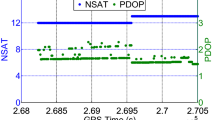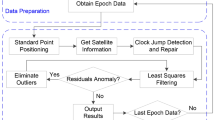Abstract
Precise point positioning (PPP) technology is capable of providing global high-precision positioning services, but its main application bottleneck is the long convergence time. Accurate and reliable carrier phase ambiguity resolution (AR) is a primary approach to accelerate PPP convergence and improve its accuracy. The best integer equivariant (BIE) method, known for its superior performance in minimizing mean square error, is gradually being adopted for PPP-AR. This study examines key aspects of the BIE algorithm, including the determination of the optimal number of candidate sets and how the number of candidates evolves during convergence. The performance of the BIE algorithm is evaluated by utilizing both post-processing products and real-time products generated at the French CNES (Centre National D’Etudes Spatiales) with static station data. The experimental results unequivocally demonstrate that the BIE algorithm significantly improves both positioning accuracy and convergence speed compared to the least-squares ambiguity decorrelation adjustment algorithm in PPP-AR. Furthermore, a verification experiment using real ship-borne kinematic data confirms the exceptional robustness of the BIE algorithm.












Similar content being viewed by others
Data availability
The GNSS observation data used is provided by the MGEX network (https://gdc.cddis.eosdis.nasa.gov/pub/gnss/product). The precise products and satellite’s biases were obtained from CNES, for CNT, http://www.ppp-wizard.net/products/REAL_TIME/; for GRG, https://gdc.cddis.eosdis.nasa.gov/pub/gnss/product.
References
Bock Y, Melgar D (2016) Physical applications of GPS geodesy: a review. Rep Prog Phys 79(10):106801. https://doi.org/10.1088/0034-4885/79/10/106801
Collins P, Bisnath S, Lahaye F, Héroux P (2010) Undifferenced GPS ambiguity resolution using the decoupled clock model and ambiguity datum fixing. Navigation 57(2):123–135. https://doi.org/10.1002/j.2161-4296.2010.tb01772.x
Duong V, Harima K, Choy S, Rizos C (2021) GNSS best integer equivariant estimation using multivariant t-distribution: a case study for precise point positioning. J Geod 95(1):10. https://doi.org/10.1007/s00190-020-01461-w
Ge M, Gendt G, Rothacher M, Shi C, Liu J (2008) Resolution of GPS carrier-phase ambiguities in Precise Point Positioning (PPP) with daily observations. J Geod 82(7):389–399. https://doi.org/10.1007/s00190-007-0187-4
Geng J, Guo J (2020) Beyond three frequencies: an extendable model for single-epoch decimeter-level point positioning by exploiting Galileo and BeiDou-3 signals. J Geod 94(1):1–15. https://doi.org/10.1007/s00190-019-01341-y
Geng J, Shi C (2017) Rapid initialization of real-time PPP by resolving undifferenced GPS and GLONASS ambiguities simultaneously. J Geod 91(4):361–374. https://doi.org/10.1007/s00190-016-0969-7
Geng J, Meng X, Dodson AH, Ge M, Teferle FN (2010) Rapid re-convergences to ambiguity-fixed solutions in precise point positioning. J Geod 84(12):705–714. https://doi.org/10.1007/s00190-010-0404-4
Geng J, Yang S, Guo J (2021) Assessing IGS GPS/Galileo/BDS-2/BDS-3 phase bias products with PRIDE PPP-AR. Satell Navig 2(1):17. https://doi.org/10.1186/s43020-021-00049-9
Kouba J, Héroux P (2001) Precise point positioning using IGS orbit and clock products. GPS Solut 5:12–28. https://doi.org/10.1007/PL00012883
Laurichesse D, Mercier F, Berthias J-P, Broca P, Cerri L (2009) Integer ambiguity resolution on undifferenced GPS phase measurements and its application to PPP and Satellite precise orbit determination. Navigation 56(2):135–149. https://doi.org/10.1002/j.2161-4296.2009.tb01750.x
Laurichesse D (2014) Phase biases for ambiguity resolution: from an undifferenced to an uncombined formulation
Li X, Ge M, Zhang X, Zhang Y, Guo B, Wang R, Klotz J, Wickert J (2013) Real-time high-rate co-seismic displacement from ambiguity-fixed precise point positioning: application to earthquake early warning. Geophys Res Lett 40(2):295–300. https://doi.org/10.1002/grl.50138
Li X, Dick G, Ge M, Heise S, Wickert J, Bender M (2014) Real-time GPS sensing of atmospheric water vapor: precise point positioning with orbit, clock, and phase delay corrections. Geophys Res Lett 41(10):3615–3621. https://doi.org/10.1002/2013GL058721
Li P, Zhang X, Ren X, Zuo X, Pan Y (2016) Generating GPS satellite fractional cycle bias for ambiguity-fixed precise point positioning. GPS Solut 20(4):771–782. https://doi.org/10.1007/s10291-015-0483-z
Liu Y, Lou Y, Ye S, Zhang R, Song W, Zhang X, Li Q (2017) Assessment of PPP integer ambiguity resolution using GPS, GLONASS and BeiDou (IGSO, MEO) constellations. GPS Solut 21(4):1647–1659. https://doi.org/10.1007/s10291-017-0641-6
Liu T, Jiang W, Laurichesse D, Chen H, Liu X, Wang J (2020) Assessing GPS/Galileo real-time precise point positioning with ambiguity resolution based on phase biases from CNES. Adv Space Res 66(4):810–825. https://doi.org/10.1016/j.asr.2020.04.054
Ma L, Lou Y, Lu L, Liu W, Zhu F (2022) GNSS best integer equivariant estimation combining with integer least squares estimation: an integrated ambiguity resolution method with optimal integer aperture test. GPS Solut 26(4):100. https://doi.org/10.1007/s10291-022-01285-5
Malys S, Jensen PA (1990) Geodetic point positioning with GPS carrier beat phase data from the CASA UNO experiment. Geophys Res Lett 17(5):651–654
Odolinski R, Teunissen PJG (2020) Best integer equivariant estimation: performance analysis using real data collected by low-cost, single- and dual-frequency, multi-GNSS receivers for short- to long-baseline RTK positioning. J Geod 94(9):91. https://doi.org/10.1007/s00190-020-01423-2
Pan L, Xiaohong Z, Fei G (2017) Ambiguity resolved precise point positioning with GPS and BeiDou. J Geod 91(1):25–40. https://doi.org/10.1007/s00190-016-0935-4
Petit G, Kanj A, Loyer S, Delporte J, Mercier F, Perosanz F (2015) 1 × 10–16 frequency transfer by GPS PPP with integer ambiguity resolution. Metrologia 52(2):301–309. https://doi.org/10.1088/0026-1394/52/2/301
Tao J, Chen G, Guo J, Zhang Q, Liu S, Zhao Q (2022) Toward BDS/Galileo/GPS/QZSS triple-frequency PPP instantaneous integer ambiguity resolutions without atmosphere corrections. GPS Solut 26(4):127. https://doi.org/10.1007/s10291-022-01287-3
Teunissen PJG (1995) The least-squares ambiguity decorrelation adjustment: a method for fast GPS integer ambiguity estimation. J Geod 70(1–2):65–82. https://doi.org/10.1007/BF00863419
Teunissen PJG (2003) Theory of integer equivariant estimation with application to GNSS. J Geod 77(7–8):402–410. https://doi.org/10.1007/s00190-003-0344-3
Teunissen PJG (2004) Penalized GNSS ambiguity resolution. J Geod 78(4–5):235–244. https://doi.org/10.1007/s00190-004-0393-2
Teunissen PJG (2005) On the computation of the best integer equivariant estimator. Artif Satell 40:161–171
Teunissen PJG (2020) Best integer equivariant estimation for elliptically contoured distributions. J Geod 94(9):82. https://doi.org/10.1007/s00190-020-01407-2
Teunissen PJG, Khodabandeh A (2015) Review and principles of PPP-RTK methods. J Geod 89(3):217–240. https://doi.org/10.1007/s00190-014-0771-3
Teunissen PJG, Verhagen S (2008) GNSS carrier phase ambiguity resolution: challenges and open problems. In: Sideris MG (ed) Observing our changing earth. Springer, Berlin Heidelberg, pp 785–792
Verhagen S (2004) Integer ambiguity validation: an open problem? GPS Solut 8(1):36–43. https://doi.org/10.1007/s10291-004-0087-5
Verhagen S, Teunissen PJG (2005) Performance comparison of the BIE estimator with the float and fixed GNSS ambiguity estimators. In: Sansò F (ed) A window on the future of geodesy. Springer, Berlin, Heidelberg, pp 428–433
Wen Z, Henkel P, Brack A, Gunther C (2012) Best integer equivariant estimation for precise point positioning. In: 54th international symposium ELMAR
Xu PL, Cannon E, Lachapelle G (1995) Mixed integer programming for the resolution of GPS carrier phase ambiguities. In IUGG95 Assembly, Boulder, July 2–14. Preprint https://arxiv.org/ 1010.1052
Zhou F, Dong D, Ge M, Li P, Wickert J, Schuh H (2017) Simultaneous estimation of GLONASS pseudorange inter-frequency biases in precise point positioning using undifferenced and uncombined observations. GPS Solut 22(1):19. https://doi.org/10.1007/s10291-017-0685-7
Zhou F, Dong D, Li W, Jiang X, Wickert J, Schuh H (2018) GAMP: an open-source software of multi-GNSS precise point positioning using undifferenced and uncombined observations. GPS Solut 22(2):33. https://doi.org/10.1007/s10291-018-0699-9
Zhou F, Cao X, Ge Y, Li W (2019) Assessment of the positioning performance and tropospheric delay retrieval with precise point positioning using products from different analysis centers. GPS Solut 24(1):12. https://doi.org/10.1007/s10291-019-0925-0
Zumberge JF, Heflin MB, Jefferson DC, Watkins MM, Webb FH (1997) Precise point positioning for the efficient and robust analysis of GPS data from large networks. J Geophys Res Solid Earth 102(B3):5005–5017. https://doi.org/10.1029/96JB03860
Acknowledgements
This study is supported by the Laoshan Laboratory (LSKJ202205104), China Postdoctoral Science Foundation (No. 2020M673669) and National Natural Science Foundation of China (12073063). We would like to thank the IGS Multi-GNSS Experiment (MGEX) for providing multi-GNSS ground tracking data, DCBs, precise orbit and clock products. The figures were generated using the public domain GMT software.
Author information
Authors and Affiliations
Contributions
YY wrote the main manuscript text and FZ designed this research. All authors reviewed the manuscript.
Corresponding author
Ethics declarations
Conflict of interest
The authors declare that they have no conflict of interest.
Additional information
Publisher's Note
Springer Nature remains neutral with regard to jurisdictional claims in published maps and institutional affiliations.
Rights and permissions
Springer Nature or its licensor (e.g. a society or other partner) holds exclusive rights to this article under a publishing agreement with the author(s) or other rightsholder(s); author self-archiving of the accepted manuscript version of this article is solely governed by the terms of such publishing agreement and applicable law.
About this article
Cite this article
Yang, Y., Zhou, F. & Song, S. Improving precise point positioning (PPP) performance with best integer equivariant (BIE) estimator. GPS Solut 28, 50 (2024). https://doi.org/10.1007/s10291-023-01585-4
Received:
Accepted:
Published:
DOI: https://doi.org/10.1007/s10291-023-01585-4




